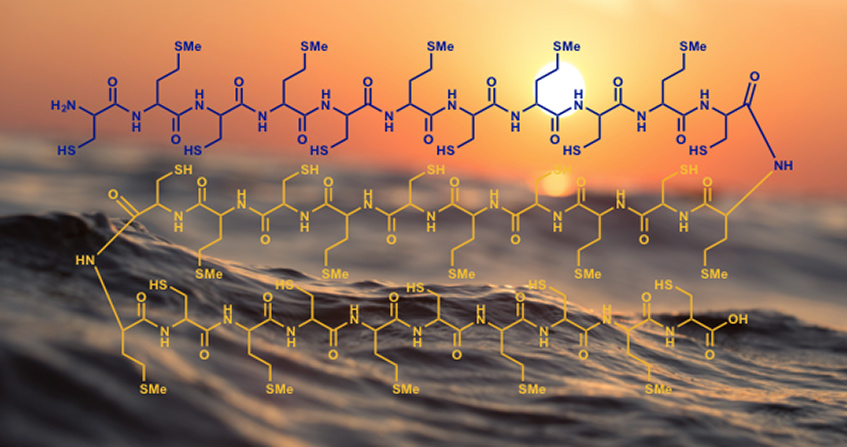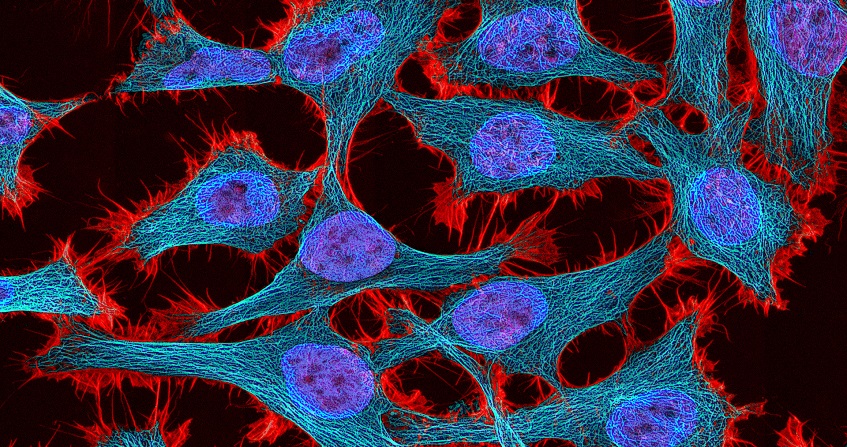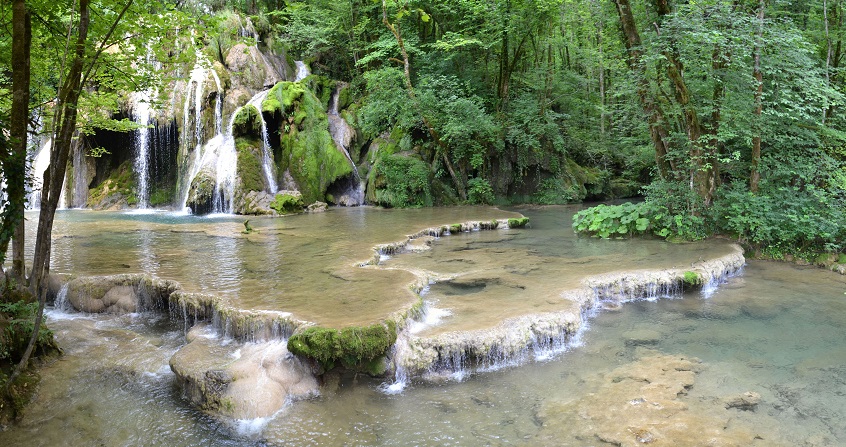The origin of life as seen by a geologist who loves astronomy
PDF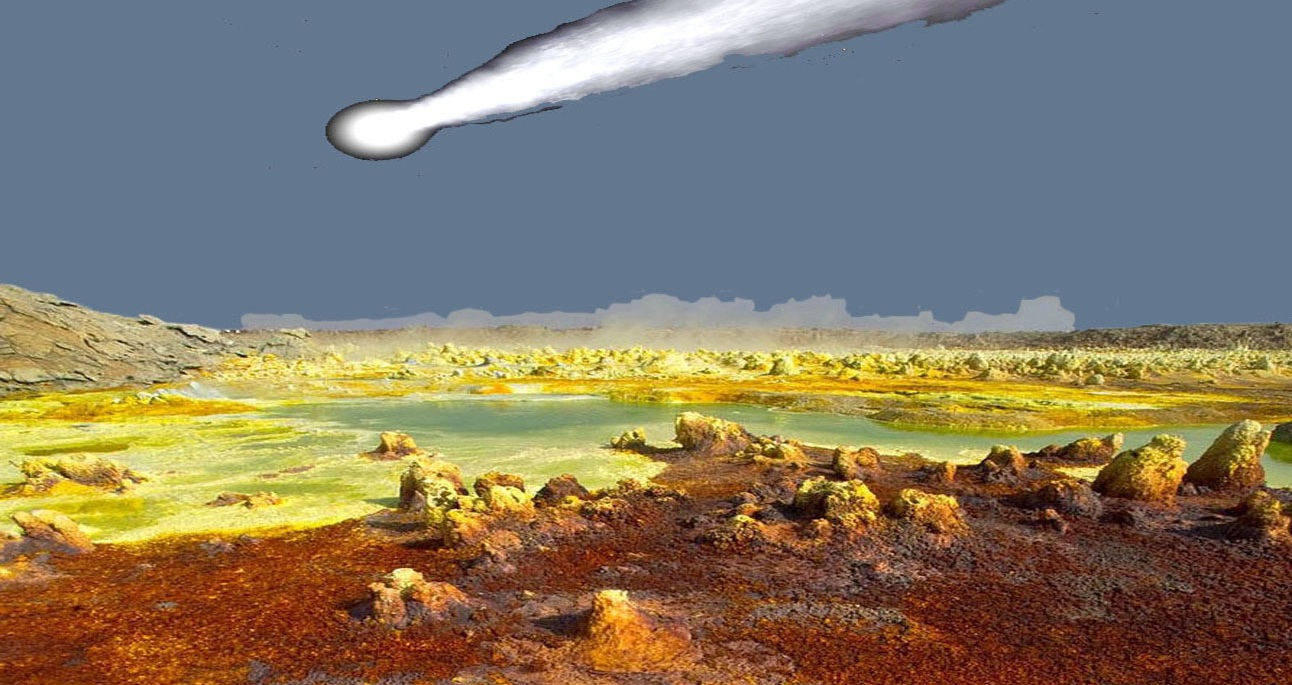
Life on Earth was born about four billion years ago, shortly after the formation of our planet, 4.54 billion years ago. While the transition from complex macromolecules to the simplest cells is still poorly understood, their origin poses far fewer problems. Their basic constituents are naturally synthesized on the surface of the dust grains that have produced comets and meteorites and in the Earth’s surface crust (the lithosphere), where hot water is in contact with iron-rich silicates. However, many meteorites and comets fell to earth around -4 billion years ago, and minerals rich in silica (silicates) and iron abounded on and below the Earth’s surface.
1. The origin of life: a story of a cell
Until the middle of the 19th century, the origin of life did not pose any problems: life was the work of a Creator. For atheists or critical believers, the theory of spontaneous generation solved the problem: life (at least simple organisms) appeared spontaneously from mineral substances when the environment was suitable. When, in the 1860s, Pasteur demonstrated that this spontaneous appearance of living organisms did not occur under natural conditions and durations compatible with laboratory experiments, the problem became crucial. One hundred and fifty years later, how can we summarize the problem? Life is above all a story of a cell (see Origin of the first cells…). To make a cell is “conceptually” quite easy. This requires 3 steps that can be described by going back in time. The most recent step is the formation of the cell itself. This requires complex organic macromolecules, polymers such as proteins, nucleic acids…, if possible with properties of auto-replication and catalytic properties. These macromolecules, present in solution or suspended in water, must also group together, create membranes that are more or less permeable, and associate into entities that isolate an internal environment from an external environment. Before this 3rd step, a 2nd step is needed, which corresponds to the manufacture of these macromolecules by polymerization of simpler but already quite complex carbon molecules such as amino acids, nitrogenous bases, simple sugars… And before this 2nd step, a 1st step is needed, i.e. to manufacture those already complex molecules that will polymerize. This first stage in the history of life, the oldest, therefore consists in synthesizing amino acids, nitrogenous bases… from simple and omnipresent molecules (carbon dioxide, CO2; water, H2O; ammonia, NH3; hydrogen cyanide, CNH…) containing the main components of life: carbon (C), hydrogen (H), oxygen (O) and nitrogen (N).
2. Fossil evidence of primitive life on Earth
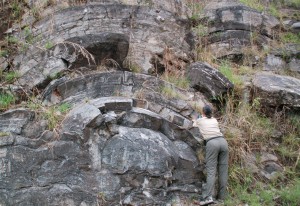
Are there any witnesses to the origin of life? To know where to look for it, you must first try to identify the environment, conditions and time in which these three stages took place. The oldest morphological traces of life forming consensus in 2016 date back -3.5 billion years. These are indirect traces found in Australian or South African sedimentary rocks showing the existence of bacterial veils and stromatolites that have a morphology quite similar to their current equivalents (Figure 1) (see The biosphere, a major geological actor). Remnants of bacterial cells are also identifiable, but their origin is still the subject of debate. In these sedimentary rocks, there is also organic matter, enriched in 12C, the light (and major) isotope of carbon. However, the synthesis of organic molecules by enzymatic processes (such as the Benson and Calvin cycle) enriches organic matter to 12C in the same proportions as found in these old rocks. No morphological life index older than 3.5 billion years is known. But we know of metamorphic rocks showing an enrichment in 12C. We know a lot about them in Greenland where they date back to -3.8 billion years ago. The oldest rocks (in fact minerals) with such anomalies in 12C have been found in Australia; they date back -4.1 billion years, suggesting that a biosphere already existed at that time. Life would have appeared on Earth at a time when the atmosphere and ocean were devoid of oxygen (O2), when the Earth was still bombarded by countless comets and meteorites, when volcanism was more abundant than today… It is in such a context that the 3 main stages that are at the origin of life had to take place.
3. The three stages of the origin of life
3.1. Forming a cell from organic macromolecules…
The geologist is not the best equipped to understand step 3: i.e. making cells from polymers and other organic macromolecules. This step left no fossil record. It can only relate to the work of chemists and biochemists, which is far from having been completed in 2016. Since the beginning of the 20th century, experiments (and more recently modelling) have indicated possible paths and suggested what could have happened: grouping polymers into films, transforming films into globules, existence of RNA having both catalytic properties, the ability to perform reduction reactions and the ability to transmit information necessary for their replication…
3.2. Manufacturing organic macromolecules by polymerization
The geologist is much more concerned with the 2nd stage of the origin of life: i.e. manufacturing these macromolecules by polymerization of simpler organic monomers such as amino acids, nitrogenous bases… Indeed, this polymerization is greatly facilitated by catalysts, and geology provides such catalysts: they are sulphides such as pyrite (FeS2) and phyllosilicates. The main ones are clays and serpentines. The surface of these minerals has the property of adsorbing monomers such as amino acids, concentrating them and greatly promoting their polymerization. Sulphides are common in volcanic regions, and clays and serpentines are abundant when water comes into contact with silicate rocks, particularly basalt and periodotites, rocks constituting the lithosphere. If, therefore, we have an aqueous medium “rich” in amino acid molecules and other organic molecules (sometimes referred to as “primitive soup“), phyllosilicates and/or sulphides, these steps 2 and 3 can then “spontaneously” give rise to proto-cells which will become the first living organisms.
3.3. Making the “molecules of life”
Which source(s) of amino acids, nitrogenous bases and other monomers (sometimes called “elementary building blocks of life”), an essential first step in the development of complex polymers such as proteins, nucleic acids and other macromolecules? Scientists studying Earth and the Solar System propose three mechanisms at the origin of this first step, three not incompatible origins.
The atmospheric origin. The first origin (chronologically speaking) was proposed in 1953: these are Miller’s famous experiments [1]. At the time, it was thought that the Earth’s atmosphere around -4 billion years ago was mainly composed of methane (CH4), ammonia (NH3), hydrogen (H2) and water (H2O). An external energy supply (electric discharge, UV photons…) is sufficient to generate more complex molecules, such as amino acids (read Once upon a time there was life...). But it is now believed that the Earth’s primitive atmosphere did not include H2, and that its carbon was mainly in the form of CO2 and not CH4. With such an atmosphere, the syntheses are not the same, and discharges and UV form almost exclusively compounds that are too oxidized. Miller’s experiments would therefore not concern the Earth. However, it is far from being ruled out that in particular sites, in an atmosphere rich in volcanic compounds for example, such syntheses may be possible. The search continues.
The alien origin. Comets and meteorites are the second possible source of the origin of life’s molecules (Figure 2). We know since 1864 with the fall of the meteorite of Pride (Tarn et Garonne) that some meteorites (the chondrites carbonaceous) contain these famous “elementary building blocks of life“. It was proven in the 1960s that these organic molecules were intrinsic to the meteorite and did not come from land-based pollution, contrary to what was mentioned (or even invoked) as soon as the Pride meteorite fell. One ton of this meteorite class contains 60 grams of amino acids, the mass of a hen’s egg, and 1.3 grams of nitrogenous bases.
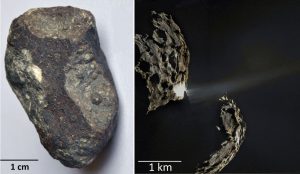
Simple organic molecules are detectable (by spectral analysis) in the tail of comets. In situ analyses by the Giotto probe (1986) and the Rosetta-Philae mission (2014-2016) confirmed the presence of organic molecules in comets. What a pity that the Philae lander could not carry out its analyses of the soil of comet 67P-CG (called Churiumov-Guerassimenko or simply Churi). But just by analyzing the volatile compounds escaping from this soil, Philae has identified 16 carbonaceous molecules, some of which are precursors to amino acid synthesis (see How to study the organic Molecules of Comets). And one of the cometary grains brought back to Earth in 2006 by the American Stardust probe contained glycine, the simplest of amino acids. Wisteria has also been detected in the tail of the comet Tchouri thanks to the Rosina instrument, installed on the Rosetta probe. When meteorites or cometary fragments and dust arrive on Earth, the majority are burned by crossing the atmosphere; however, a significant portion arrive intact at the surface. Based on the current flow of meteorites and that of the past (deduced from lunar studies), and depending on the organic carbon content of these objects, we have estimated that 1015 to 1016 kg of organic molecules arrived on Earth without being destroyed between -4.5 and -4 billion years ago. These extraterrestrial organic molecules are believed to date much of the origin of the solar system. The external dusts of the pre-solar nebula (those that gathered to become comets and carbonaceous chondrites) must have been rich in H2O ice and other small molecules (CO, CO2, CH4, NH3, CH3O…). And when such a mixture of ice is irradiated with UV photons or cosmic rays, more complex molecules are formed, including our famous elementary bricks.
The geological origin. The ocean floor and/or subsoil of the continents are the 3rd possible source of the origin of life in the form of organic molecules. We know how to make organic molecules with H2 and CO2 at high or medium temperature in the presence of suitable catalysts:
CO2 + 4 H2 → CH4 (and other more complex molecules) + 2 H2O (Fischer-Tropsch reaction)
In the presence of NH3 (ammonia) or HCN (hydrogen cyanide), amino acids and nitrogen bases may be synthesized (Strecker reaction). However, when water that is not too cold (T ≥ 80°C) comes into contact with silicates containing iron in the Fe2+ form (olivine, pyroxene, etc.), a reaction occurs whose type can be summarized by the following equation:
Olivine + H2O → serpentine + brucite + magnetite + H2
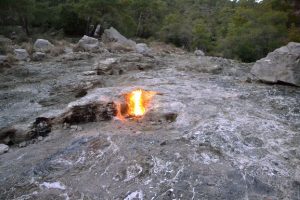
H2 can therefore be synthesized as soon as water (seawater, groundwater, etc.) comes into contact with hot olivine-rich rocks such as peridotite (Figure 3). This reaction produces magnetite (Fe3O4) and serpentine. However, magnetite is a catalyst that promotes Ficher-Tropsch-type reactions. In addition, brucite (Mg[OH]2) maintains a basic environment that promotes Strecker-type reactions. And it turns out that serpentine is a very good catalyst for the polymerization of organic monomers. These sites where water is in contact with hot olivines therefore had “everything it takes” for life to appear: typical amino acid monomers, and a catalyst to polymerize them. The other two proposed mechanisms (monomers brought by meteorites or comets, or synthesized in the atmosphere and then dropped to the ground) require another condition: that they have arrived in a geographical area rich in phyllosilicates. But there is no shortage of phyllosilicates.
4. Conclusion and perspectives of the origin of life
All of the above strongly suggests that the origin of life is a spontaneous phenomenon that is “quite easy” to achieve because it does not require any exceptional conditions; the “speed” with which life appeared on Earth reinforces this impression. The terms “easy” and “fast” must obviously be understood in a geological sense. “Fast” means that life took less than 400 million years to appear, or less than 8% of the Earth’s history. And “easy” must be understood in the sense that a puzzle is “easy” when it is done “quickly”. All this also suggests that life could have appeared wherever there was liquid water, meteorite and comet arrivals and/or water in contact with olivine or pyroxenes. Such sites are not lacking in the solar system, particularly Mars, Europe (Jupiter satellite), Enceladus (Saturn satellite), not to mention countless extrasolar planets. Future research will tell us what’s going on! As for Mars, Europe and Enceladus, it is “just” a matter of time to go and see them on site, as they are accessible from Earth using space probes. For extra-solar planets, which cannot be studied in situ in the foreseeable future, it will be necessary to make do with spectral studies of their atmosphere and surface. One of the easiest avenues to explore, although still outside our instrumental reach in 2016, will be to look in the atmosphere of an exoplanet for the coexistence of spectral lines of highly oxidizing (such as O2) and highly reducing (such as CH4) compounds. This coexistence will prove that there is a strong chemical imbalance in this atmosphere. But life is a tremendous source of chemical imbalance!
References and notes
[1] Miller SL & Urey HC (1959) Organic Compound Synthesis on the Primitive Earth, Science, 130, pp. 245-251.
The Encyclopedia of the Environment by the Association des Encyclopédies de l'Environnement et de l'Énergie (www.a3e.fr), contractually linked to the University of Grenoble Alpes and Grenoble INP, and sponsored by the French Academy of Sciences.
To cite this article: THOMAS Pierre (January 5, 2025), The origin of life as seen by a geologist who loves astronomy, Encyclopedia of the Environment, Accessed April 5, 2025 [online ISSN 2555-0950] url : https://www.encyclopedie-environnement.org/en/life/origin-of-life-seen-by-geologist-who-loves-astronomy/.
The articles in the Encyclopedia of the Environment are made available under the terms of the Creative Commons BY-NC-SA license, which authorizes reproduction subject to: citing the source, not making commercial use of them, sharing identical initial conditions, reproducing at each reuse or distribution the mention of this Creative Commons BY-NC-SA license.





